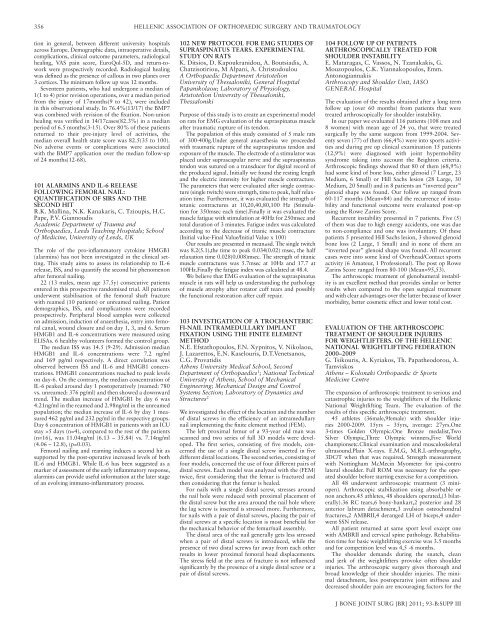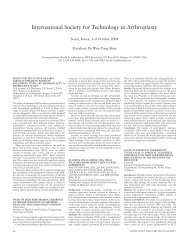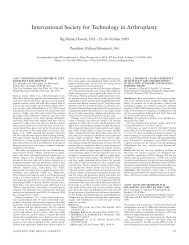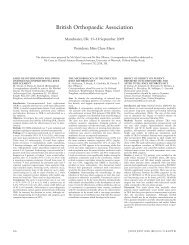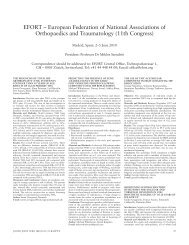Procs III 2011.indb - Journal of Bone & Joint Surgery, British Volume ...
Procs III 2011.indb - Journal of Bone & Joint Surgery, British Volume ...
Procs III 2011.indb - Journal of Bone & Joint Surgery, British Volume ...
Create successful ePaper yourself
Turn your PDF publications into a flip-book with our unique Google optimized e-Paper software.
356 HELLENIC ASSOCIATION OF ORTHOPAEDIC SURGERY AND TRAUMATOLOGY<br />
tion in general, between different university hospitals<br />
across Europe. Demographic data, intraoperative details,<br />
complications, clinical outcome parameters, radiological<br />
healing, VAS pain score, EuroQol-5D, and return-towork<br />
were prospectively recorded. Radiological healing<br />
was defi ned as the presence <strong>of</strong> callous in two planes over<br />
3 cortices. The minimum follow up was 12 months.<br />
Seventeen patients, who had undergone a median <strong>of</strong><br />
1(1 to 4) prior revision operations, over a median period<br />
from the injury <strong>of</strong> 17months(9 to 42), were included<br />
in this observational study. In 76.4%(13/17) the BMP7<br />
was combined with revision <strong>of</strong> the fi xation. Non-union<br />
healing was verifi ed in 14/17cases(82.3%) in a median<br />
period <strong>of</strong> 6.5 months(3-15). Over 80% <strong>of</strong> these patients<br />
returned to their pre-injury level <strong>of</strong> activities, the<br />
median overall health state score was 82.5(35 to 100).<br />
No adverse events or complications were associated<br />
with the BMP7 application over the median follow-up<br />
<strong>of</strong> 24 months(12-68).<br />
101 ALARMINS AND IL-6 RELEASE<br />
FOLLOWING FEMORAL NAIL:<br />
QUANTIFICATION OF SIRS AND THE<br />
SECOND HIT<br />
R.K. Mallina, N.K. Kanakaris, C. Tzioupis, H.C.<br />
Pape, P.V. Giannoudis<br />
Academic Department <strong>of</strong> Trauma and<br />
Orthopaedics, Leeds Teaching Hospitals; School<br />
<strong>of</strong> Medicine, University <strong>of</strong> Leeds, UK<br />
The role <strong>of</strong> the pro-infl ammatory cytokine HMGB1<br />
(alarmins) has not been investigated in the clinical setting.<br />
This study aims to assess its relationship to IL-6<br />
release, ISS, and to quantify the second hit phenomenon<br />
after femoral nailing.<br />
22 (13 males, mean age 37.5y) consecutive patients<br />
entered in this prospective randomised trial. All patients<br />
underwent stabilisation <strong>of</strong> the femoral shaft fracture<br />
with reamed (10 patients) or unreamed nailing. Patient<br />
demographics, ISS, and complications were recorded<br />
prospectively. Peripheral blood samples were collected<br />
on admission, induction <strong>of</strong> anaesthesia, entry into femoral<br />
canal, wound closure and on day 1, 3, and 6. Serum<br />
HMGB1 and IL-6 concentrations were measured using<br />
ELISAs. 6 healthy volunteers formed the control group.<br />
The median ISS was 14.5 (9-29). Admission median<br />
HMGB1 and IL-6 concentrations were 7.2 ng/ml<br />
and 169 pg/ml respectively. A direct correlation was<br />
observed between ISS and IL-6 and HMGB1 concentrations.<br />
HMGB1 concentrations reached to peak levels<br />
on day-6. On the contrary, the median concentration <strong>of</strong><br />
IL-6 peaked around day 1 postoperatively (reamed: 780<br />
vs. unreamed: 376 pg/ml) and then showed a downward<br />
trend. The median increase <strong>of</strong> HMGB1 by day 6 was<br />
4.21ng/ml in the reamed and 2.98ng/ml in the unreamed<br />
population; the median increase <strong>of</strong> IL-6 by day 1 measured<br />
462 pg/ml and 232 pg/ml in the respective groups.<br />
Day 6 concentration <strong>of</strong> HMGB1 in patients with an ICU<br />
stay >5 days (n=4), compared to the rest <strong>of</strong> the patients<br />
(n=16), was 11.04ng/ml (6.13 – 35.84) vs. 7.14ng/ml<br />
(4.06 – 12.8), (p=0.03).<br />
Femoral nailing and reaming induces a second hit as<br />
supported by the post-operative increased levels <strong>of</strong> both<br />
IL-6 and HMGB1. While IL-6 has been suggested as a<br />
marker <strong>of</strong> assessment <strong>of</strong> the early infl ammatory response,<br />
alarmins can provide useful information at the later stage<br />
<strong>of</strong> an evolving immuno-infl ammatory process.<br />
102 NEW PROTOCOL FOR EMG STUDIES OF<br />
SUPRASPINATUS TEARS. EXPERIMENTAL<br />
STUDY ON RATS<br />
K. Ditsios, D. Kapoukranidou, A. Boutsiadis, A.<br />
Chatzisotiriou, M Alpani, A. Christodoulou<br />
A Orthopaedic Department Aristotelion<br />
University <strong>of</strong> Thessaloniki, General Hospital<br />
Papanikolaou; Laboratory <strong>of</strong> Physiology,<br />
Aristotelion University <strong>of</strong> Thessaloniki,<br />
Thessaloniki<br />
Purpose <strong>of</strong> this study is to create an experimental model<br />
on rats for EMG evaluation <strong>of</strong> the supraspinatus muscle<br />
after traumatic rupture <strong>of</strong> its tendon.<br />
The population <strong>of</strong> this study consisted <strong>of</strong> 5 male rats<br />
<strong>of</strong> 300-400g.Under general anaesthesia we proceeded<br />
with traumatic rupture <strong>of</strong> the supraspinatus tendon and<br />
exposure <strong>of</strong> the muscle. The electrode <strong>of</strong> a stimulator was<br />
placed under suprascapular nerve and the supraspinatus<br />
tendon was sutured on a transducer for digital record <strong>of</strong><br />
the produced signal. Initially we found the resting length<br />
and the electric intensity for higher muscle contracture.<br />
The parameters that were evaluated after single contracture<br />
(single twitch) were strength, time to peak, half relaxation<br />
time. Furthermore, it was evaluated the strength <strong>of</strong><br />
tetanic contractures at 10,20,40,80,100 Hz (Stimulation<br />
for 350msec each time).Finally it was evaluated the<br />
muscle fatigue with stimulation at 40Hz for 250msec and<br />
total duration <strong>of</strong> 3 minutes. Fatigue index was calculated<br />
according to the decrease <strong>of</strong> titanic muscle contracture<br />
(Initial value-Final Value/Initial Value x 100)<br />
Our results are presented in mean±sd. The single twitch<br />
was 8.2(5.1),the time to peak 0.034(0.02) msec, the half<br />
relaxation time 0.028(0.008)msec. The strength <strong>of</strong> titanic<br />
muscle contractures was 5.7msec at 10Hz and 17.7 at<br />
100Hz.Finally the fatigue index was calculated at 48.4.<br />
We believe that EMG evaluation <strong>of</strong> the supraspinatus<br />
muscle in rats will help us understanding the pathology<br />
<strong>of</strong> muscle atrophy after rotator cuff tears and possibly<br />
the functional restoration after cuff repair.<br />
103 INVESTIGATION OF A TROCHANTERIC<br />
FI-NAIL INTRAMEDULLARY IMPLANT<br />
FIXATION USING THE FINITE ELEMENT<br />
METHOD<br />
N.E. Efstathopoulos, F.N. Xypnitos, V. Nikolaou,<br />
J. Lazarettos, E.N. Kaselouris, D.T.Venetsanos,<br />
C.G. Provatidis<br />
Athens University Medical School, Second<br />
Department <strong>of</strong> Orthopaedics 1 ; National Technical<br />
University <strong>of</strong> Athens, School <strong>of</strong> Mechanical<br />
Engineering; Mechanical Design and Control<br />
Systems Section; Laboratory <strong>of</strong> Dynamics and<br />
Structures 2<br />
We investigated the effect <strong>of</strong> the location and the number<br />
<strong>of</strong> distal screws in the effi ciency <strong>of</strong> an intramedullary<br />
nail implementing the fi nite element method (FEM).<br />
The left proximal femur <strong>of</strong> a 93-year old man was<br />
scanned and two series <strong>of</strong> full 3D models were developed.<br />
The fi rst series, consisting <strong>of</strong> fi ve models, concerned<br />
the use <strong>of</strong> a single distal screw inserted in fi ve<br />
different distal locations. The second series, consisting <strong>of</strong><br />
four models, concerned the use <strong>of</strong> four different pairs <strong>of</strong><br />
distal screws. Each model was analyzed with the (FEM)<br />
twice, fi rst considering that the femur is fractured and<br />
then considering that the femur is healed.<br />
For nails with a single distal screw, stresses around<br />
the nail hole were reduced with proximal placement <strong>of</strong><br />
the distal screw but the area around the nail hole where<br />
the lag screw is inserted is stressed more. Furthermore,<br />
for nails with a pair <strong>of</strong> distal screws, placing the pair <strong>of</strong><br />
distal screws at a specifi c location is most benefi cial for<br />
the mechanical behavior <strong>of</strong> the femur/nail assembly.<br />
The distal area <strong>of</strong> the nail generally gets less stressed<br />
when a pair <strong>of</strong> distal screws is introduced, while the<br />
presence <strong>of</strong> two distal screws far away from each other<br />
results in lower proximal femoral head displacements.<br />
The stress fi eld at the area <strong>of</strong> fracture is not infl uenced<br />
signifi cantly by the presence <strong>of</strong> a single distal screw or a<br />
pair <strong>of</strong> distal screws.<br />
104 FOLLOW UP OF PATIENTS<br />
ARTHROSCOPICALLY TREATED FOR<br />
SHOULDER INSTABILITY<br />
E. Mataragas, C. Vassos, N. Tzanakakis, G.<br />
Mouzopoulos, C.K. Yiannakopoulos, Emm.<br />
Antonogiannakis<br />
Arthroscopy and Shoulder Unit, IASO<br />
GENERAL Hospital<br />
The evaluation <strong>of</strong> the results obtained after a long term<br />
follow up (over 60 months) from patients that were<br />
treated arthroscopically for shoulder instability.<br />
In our paper we evaluated 116 patients (108 men and<br />
8 women) with mean age <strong>of</strong> 24 yo, that were treated<br />
surgically by the same surgeon from 1999-2004. Seventy<br />
seven (77) <strong>of</strong> them (66,4%) were into sports activities<br />
and during pre op clinical examination 15 patients<br />
(12,9%) were diagnosed with joint hypermobility<br />
syndrome taking into account the Beighton criteria.<br />
Arthroscopic fi ndings showed that 80 <strong>of</strong> them (68,9%)<br />
had some kind <strong>of</strong> bone loss, either glenoid (7 Large, 23<br />
Medium, 6 Small) or Hill Sachs lesion (28 Large, 30<br />
Medium, 20 Small) and in 8 patients an “inverted pear”<br />
glenoid shape was found. Our follow up ranged from<br />
60-117 months (Mean=84) and the recurrence <strong>of</strong> instability<br />
and functional outcome were evaluated post-op<br />
using the Rowe Zarins Score.<br />
Recurrent instability presented in 7 patients. Five (5)<br />
<strong>of</strong> them was due to high energy accidents, one was due<br />
to non-compliance and one was involuntary. Of these<br />
patients 5 presented Hill Sachs lesion, 3 showed glenoid<br />
bone loss (2 Large, 1 Small) and in none <strong>of</strong> them an<br />
“inverted pear” glenoid shape was found. All recurrent<br />
cases were into some kind <strong>of</strong> Overhead/Contact sports<br />
activity (6 Amateur, 1 Pr<strong>of</strong>essional). The post op Rowe<br />
Zarins Score ranged from 80-100 (Mean=95,53).<br />
The arthroscopic treatment <strong>of</strong> glenohumeral instability<br />
is an excellent method that provides similar or better<br />
results when compared to the open surgical treatment<br />
and with clear advantages over the latter because <strong>of</strong> lower<br />
morbidity, better cosmetic effect and lower total cost.<br />
EVALUATION OF THE ARTHROSCOPIC<br />
TREATMENT OF SHOULDER INJURIES<br />
FOR WEIGHTLIFTERS. OF THE HELLENIC<br />
NATIONAL WEIGHTLIFTING FEDERATION<br />
2000–2009<br />
G. Tsikouris, A. Kyriakos, Th. Papatheodorou, A.<br />
Tamviskos<br />
Athens – Kolonaki Orthopaedic & Sports<br />
Medicine Centre<br />
The expansion <strong>of</strong> arthroscopic treatment to serious and<br />
catastrophic injuries to the weightlifters <strong>of</strong> the Hellenic<br />
National Weightlifting Team. The evaluation <strong>of</strong> the<br />
results <strong>of</strong> this specifi c arthroscopic treatment.<br />
45 athletes (36male,9female) with shoulder injuries<br />
2000-2009. 15yrs – 35yrs, average: 27yrs.One<br />
3-times Golden Olympic.One Bronze medalist,Two<br />
Silver Olympic,Three Olympic winners,Five World<br />
championsetc.Clinical examination and musculoskeletal<br />
ultrasound.Plain X-rays. E.M.G, M.R.I.-arthrography,<br />
3DC/T when that was required. Strength measurement<br />
with Nottingham McMecin Myometer for ipsi-contro<br />
lateral shoulder. Full ROM was necessary for the operated<br />
shoulder before starting exercise for a competition.<br />
All 48 underwent arthroscopic treatment (3 miniopen).<br />
Arthroscopic stabilization using absorbable or<br />
non anchors.45 athletes, 48 shoulders operated,(3 bilaterally).36<br />
RC tears,6 bony-bankart,2 posterior and 28<br />
anterior labrum detachment,3 avulsion osteochondral<br />
fractures,2 AMBRII,4 deranged LH <strong>of</strong> biceps,4 underwent<br />
SSN release.<br />
All patient returned at same sport level except one<br />
with AMBRII and cervical spine pathology. Rehabilitation<br />
time for basic weightlifting exercise was 3.5 months<br />
and for competition level was 4,5 -6 months.<br />
The shoulder demands during the snatch, clean<br />
and jerk <strong>of</strong> the weightlifters provoke <strong>of</strong>ten shoulder<br />
injuries. The arthroscopic surgery gives thorough and<br />
broad knowledge <strong>of</strong> their shoulder injuries. The minimal<br />
detachment, less postoperative joint stiffness and<br />
decreased shoulder pain are encouraging factors for the<br />
J BONE JOINT SURG [BR] 2011; 93-B:SUPP <strong>III</strong>


